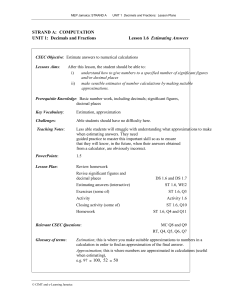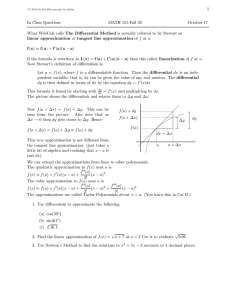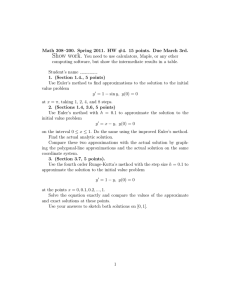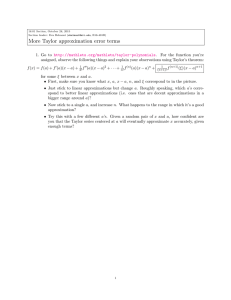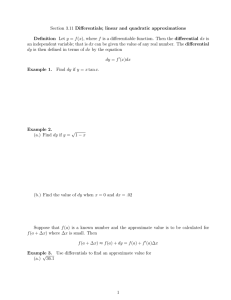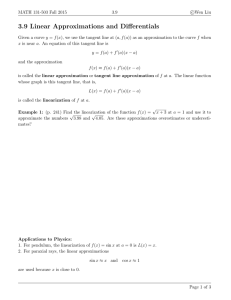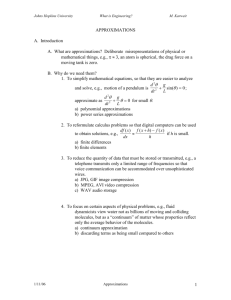ASYMPTOTICS WINDOW FOR OPEN-LOOP FLOW
advertisement
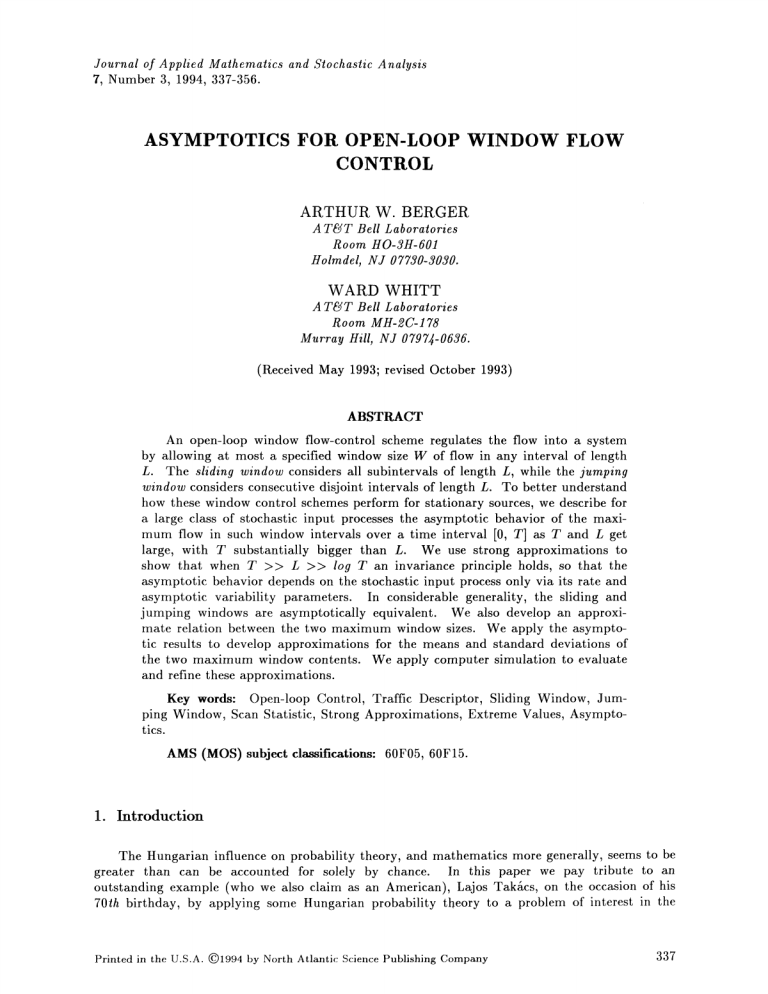
Journal of Applied Mathematics and Stochastic Analysis
7, Number 3, 1994, 337-356.
ASYMPTOTICS FOR OPEN-LOOP WINDOW FLOW
CONTROL
ARTHUR W. BERGER
A TT Bell Laboratories
Room HO-3H-501
Holmdel, Nl 07730-303t).
WARD WHITT
A TT Bell Laboratories
Room MH-2C-178
Murray Hill, NJ 0797-0535.
(Received May 1993;
revised October
1993)
ABSTRACT
An open-loop window flow-control scheme regulates the flow into a system
by allowing at most a specified window size W of flow in any interval of length
L. The sliding window considers all subintervals of length L, while the jumping
window considers consecutive disjoint intervals of length L. To better understand
how these window control schemes perform for stationary sources, we describe for
a large class of stochastic input processes the asymptotic behavior of the maximum flow in such window intervals over a time interval [0, T] as T and L get
large, with T substantially bigger than L. We use strong approximations to
show that when T >> L > log T an invariance principle holds, so that the
asymptotic behavior depends on the stochastic input process only via its rate and
asymptotic variability parameters. In considerable generality, the sliding and
jumping windows arc asymptotically equivalent. We also develop an approximate relation between the two maximum window sizes. We apply the asymptotic results to develop approximations for the means and standard deviations of
the two maximum window contents. We apply computer simulation to evaluate
and refine these approximations.
Key words: Open-loop Control, Traffic Descriptor, Sliding Window, Jumping Window, Scan Statistic, Strong Approximations, Extreme Values, Asymptotics.
AMS (MOS) subject classifications: 60F05, 60F15.
1. Introduction
The Hungarian influence on probability theory, and mathematics more generally, seems to be
greater than can be accounted for solely by chance. In this paper we pay tribute to an
outstanding example (who we also claim as an American), Lajos Takcs, on the occasion of his
70th birthday, by applying some Hungarian probability theory to a problem of interest in the
Printed in the U.S.A.
(C)1994 by North
Atlantic Science Publishing Company
337
ARTHUR W. BERGER and WARD WHITT
338
design of emerging high-speed communication networks. In particular, we apply strong approximations as in Koml6s, Major and Tusndy [9], [12], Cs6rg5 and Rvsz [6] and Cshrgh, Horvth
and Steinebach [5] to study open-loop window flow-control schemes. We also refer to relate work
by Erdhs and Rnyi [7].
The most familiar window flow-control scheme is a closed-loop control mechanism. Sources
regulate their flow into the system (e.g., packets into a network) by keeping track of the flow that
has been transmitted but not yet received, typically using acknowledgements sent back from the
receiver to the source. The source stops sending when the unacknowledged flow reaches a specified window size; e.g., see pp. 97 and 429 of Bertsekas and Gallager [2].
In contrast, open-loop window flow-control schemes use only local information. For highspeed communication networks, there is growing interest in open-loop control schemes, because
end-to-end delays over long distances can become very large relative to the time significant
change in the network state occurs; see Budka [3], Reibman and Berger [14] and Sections 2.2 and
3.3 of Roberts [15]. The idea in the open-loop window flow control is to simply limit the
maximum input in any interval (window) of specified length. Our purpose here is to gain a
better understanding of the way these open-loop window control schemes perform for stationary
sources. To do this, we study open-loop sliding and jumping window control schemes via
asymptotics.
Let I(t) represent the input to a system in the interval [0, t]. We regard I(t) as random, so
that I {I(t) t > 0} is a real-valued stochastic process. We think of I as being nondecreasing
and integer valued, but neither of these properties are required. Let T be the time period and let
L be the window length. For simplicity, assume that T is a multiple of L. Let J J(L,T,I) be
the random variable representing the maximum jumping window content as a function of L, T,
and I, i.e.,
max(I(kL)- I((k- 1)L)" 1 < k < T/L),
J(L,T,I)
J
and let S S(L,T,I) be the random variable representing the maximum sliding window content
as a function of L, T, and I, i.e.,
S
S(L,T,I)
sup{I(t + L)- I(t) 0 < t < T- L}.
In the statistics literature, the sliding window is also called the scan statistic;
More related literature is cited there.
see
Naus [12], [13].
A trivial consequence of these definitions is the ordering
J(L,T,I) < S(L,T,I) w.p.1.
Moreover, since any interval of length L yielding a maximum for S is contained in two
consecutive intervals in J, and since the maximum jumping window is at least as big as each of
these,
S(L,T,I) <_ 2J(L,T,I) w.p.1.
Hence, for any process I and any time interval [0, T], the ratio J/S is a random
0.5 < J/S < 1. One purpose here is to develop approximations for this ratio.
variable with
In general, the distributions of J and S depend on the distribution of the stochastic process I
in a rather complicated way. However, as T and L become large, some statistical regularity
emerges. Since it is natural to consider large values of T and L in communication network
Asymptotics
for Open-Loop
Window Flow Control
339
applications, in the remaining sections we discuss asymptotics. We start in 2 by reviewing the
central limit theorem and strong approximations, which justify an approximation by Brownian
motion. In 3 we consider extreme-value asymptotics for Brownian motion as T-cx. In 4 we
provide conditions for the Brownian approximation to be asymptotically correct and establish
limits for S and J as both T and L get large. In particular, there we develop support for the
following relatively simple approximations for the random variables (and their means) provided
that log T << L << T, where << means much smaller than:
(1)
where
1.28
,3(T,L) = V/21og(T/L) + 2log log T V/21og(T/L)
J
EJ
AL + Cj(T,L)V/Ac2L,
where
-
V/21og(T/L)-
Cj(T,L)
S-
log log(T/L)+ 1.38
E._
ES- L
2V/21og(T/L
L
" s(T, L)
for (I) S and (I)j defined above. In (1)-(3), A is the rate and c 2 is the asymptotic variability
parameter of I (defined in (6) below). In (1)-(3) and throughout the paper, log means the
natural logarithm, i.e., to the base e. Without loss of generality (by the choice of the measuring
units), we can let A- 1. Hence, there are really only three parameters in (1)- (3)" L, T, and c 2.
The approximations for S and J in (1) and (2) have a simple interpretation: The first term
is the approximate
mean for a single interval of length L; the term
standard deviation for a single interval of length L; and the remaining factors (s(T, L) for S in
(1) and (j(T,L) for g in (2) represent the increase due to the maximization. It is significant that
the factors (I) S and (I)j depend only on T and L, and not upon A and c 2.
AL is the approximate
Note that, by (3), the ratio (J-AL)/(S-L)approaches 1 as T---,cx, but (3) provides an
approximation for the ratio for finite T. This ratio estimate as a function of L and T is displayed
in Table 1. We can also use (1) and (2) to develop an approximate expansion directly for the
In particular, by (1) and (2),
ratio J/S in powers of
1/.
J
1+
1+
However,
we will focus on
j
VC
2
c2
%) +
c2
%)
s
(3).
The maximum window contents S and J are of course random variables. We also derive
rough estimates for the standard deviations, namely,
SOY(S)
/ Ac2L
, SOY(J) 1.281Olo-27-7=,L
V l
(4)
ARTHUR W. BERGER and WARD WHITT
340
Moreover,
we would approximate the distributions of S and J, after appropriate
the
type-/ extreme-value distribution, i.e., the cdf (cumulative distribution
normalization, by
function) exp(-e-x), -o < x < c.; see p. 4 of Leadbetter, Lindgren and RootzSn [11] and
(10) -(13) below.
see Section 3.
We can combine (1), (2), and (4) to obtain estimates of the coefficients of variation (CV,
standard deviation divided by the mean) of S-SL and J-SL. Keeping only the dominant
V/21og(T/L) term in (I) and (I), we obtain
CV(S- )tL) ,, CV(J- )tL)
Hence, if T/L-10 k, then CV(S-$L) 0.278/k.
S- SL should be less than 10% of the mean.
,, logO(’6TL)._
If k
> 3,
(5)
then the standard deviation of
In 5 we briefly discuss discriminating windows with L O(log T), for which the asymptotics
depend upon more than two parameters $ and c 2, and thus have more potential for providing
information about the input process.
-
In 6 we make numerical comparisons using computer simulations. In particular, we consider
10 replications each of several renewal processes with
1, T 106 and various values of L.
These simulation experiments provide additional support for approximations (1)- (5). Indeed,
the last term in (I, s in (1) was suggested by the simulations. In 7 we state our conclusions.
We were motivated to look for approximations (1) and (2), because we want to compare the
open-loop window flow-control schemes to other open-loop flow-control schemes. In particular, in
[1] we compare the sliding window to a leaky-bucket-based flow-control scheme. There we
conclude that the sliding window admits larger bursts than the leaky bucket for given peak rate
and given sustainable rate. To draw this conclusion, we carry out a specific construction: We
generate a sample path of a stationary point process I and specify a window length L. The
reciprocal of the observed minimum distance between consecutive points is the realized peak rate,
and the ratio S/L is the maximum possible sustainable rate, when S S(L,T,I) is the maximum
sliding window content. With this peak rate and sustainable rate, the observed sample path just
passes through the sliding window control. We then let the leaky bucket have drain rate v equal
to the sustainable rate for the sliding window, and let the bucket capacity be the smallest level
such that the observed stochastic sample path just passes through the leaky bucket. With this
construction, both controls have the same peak and sustainable rates, and the given sample path
just passes through both controls. Finally, with the control parameters so determined, we ask
which control scheme allows larger bursts, where a burst is defined as the maximum number of
consecutive arrivals at the peak rate. We find that the sliding window allows larger bursts, and
we use (1) to estimate the difference. See [1] for more details. Reibman and Berger [14] reach the
same conclusions for sample video teleconferencing sequences.
2. The Central Limit Theorem and
Strong Approximations
First, as T gets large, we can apply extreme value theory, as in Leadbetter, Lindgren and
Rootzn [11]. In general, though, the limiting behavior depends quite delicately upon the input
process I. However, if we can assume that L also is suitably large, then we can hope for
significant simplification. As L gets large, in great generality, each increment I(t + L)-I(t)
becomes approximately normally distributed by the central limit theorem (CLT), i.e.,
I(t+L)-I(t)-AL g(0,1)as L-oc
(6)
V/Ac2L
Asymptotics
for Open-Loop
Window Flow Control
341
for all t, where =: denotes convergence in distribution, N(0,1) denotes a standard (zero mean,
unit variance) normal random variable, A is a positive constant called the input rate and c 2 is a
positive constant called the asymptotic variability parameter.
To have the CLT (6), we need to have the second moment EI(t) 2 finite and we need to have
the dependence between the increments I(t + h)-I(t) and I(s)-I(s-h) for s <t and h > 0
decrease suitably as t- s increases. We assume that we do not have infinite second moments or
the long-range dependence that would invalidate (6).
If I is a stationary stochastic point process (i.e., has stationary increments) then c 2 is
typically the limiting value of the index of dispersion for counts (IDC), i.e.,
c 2-
Vat I(t)
I c(oc -lira
(7)
EI(t------
t-o
71 of Cox and Lewis [4]. (The role of the second moment condition is clear in
renewal counting process with i.i.d interrenewal times X k, then c 2 is the squared
variation of (SCV) of X1, i.e.,
see p.
C 2-
(It
SCV(X1)-
(7).) If I is a
coefficient of
Vat X 1
(EX1) 2
is important that a square appears in the denominator of
(8),
but not in
(7).)
In fact, we need more than (6), and we often have it. In great generality, a properly
normalized input process such as I can be approximated by a Brownian motion. Indeed, our key
assumption will be that I can be approximated strongly by a Brownian motion, i.e., there exists a
_> 0} such that
standard (zero drift, unit variance) Brownian motion (BM) B {B(t)
0
see
<_
t<_T}-O(logT)
(9)
w.p.lasToe;
CsSrg6 and R6v4sz [6] and Csarg6, Horvth and Steinebach [5]. These references show that
holds in great generality, so that this seems to be a reasonable starting point for us. Note
that (9) can be regarded as a form of functional central limit theorem (FELT) generalizing the
CLT in (6). To convert (9) into the FELT, replace in (9) by nt, T by n, and then divide by
X/. This yields
(9)
"0
V/Ac2n
and note that tbr each n,
from (9) we get
<_ t<_l -0
{B(nt)/v/-" t>_O}
I(nt)-Ant
V/-,
w.p. 1 as n----oe
is distributed the same as
=V
B(t)
with the convergence being in the Nnction space
%rther discussion.
{B(t)" t>_O}. Hence,
as
D[0, 1];
see pp. 11-
-
15 and 88-95 of
[6]
for
(9) can be regarded as best possible; see [5], [6]. For a
and SCV c 2, (9) holds when
times
X k having mean I
renewal process with interrenewal
It is also significant that the
e sX1 <
(Other
error in
for some s > 0; see Corollary 3.1 on p. 1450 of CsSrg5 ttorvth and Steinebach [5].
< Nr some p > 2; see
strong approximations hold with bigger errors when only
EX
ARTHUR W. BERGER and WARD WHITT
342
[5], [6].) Theorem 3.1
dependent intervals.
a fluid model.
[5]
also provides a means to treat a large class of counting processes with
Moreover, I(t) need not be a counting process; e.g., it could be the input in
of
In applications, e.g., to communications networks, we are often interested in large L and large
T. A key issue in the asymptotics is the way these two parameters grow. We consider this issue
in
4.
3. Extreme Values for Brownian Motion
sur
ose that I can be approximated by a BM. Consistent with (9),
we simply
2
t / /c B(t), where B is a standard BM. In this case, we can apply
we assume that I(t)
classical results to describe J and S as T--,cx for any fixed L, omitting I from the notation. In
particular, by the extreme-value theorem for i.i.d, normal random variables in Theorem 1.5.3 on
In this section
p. 14 of
[11],
a(L,T)(J(L,T)- )L- b(L,T)):::Z as Toc,
(10)
where Z is the classical type-/extreme-value distribution with cdf
P(Z <_ x) = exp(-e-x),
oc
(11)
< x < c,
a(L,T)- 21og(T/L)/$c2L
(12)
and
b(L,T)-v/AC2L[v/21og(T/L) -[lg
Note
that
EZ-0.5772
log(T/L)+log
2V/2.1og(T/L
4r]]
(13)
(Euler’s constant), VarZ-r2/6-1.645, SCV(Z)-4.94,
median(Z) 0.3667 and mod(Z)= 0.9624 for the type-/ extreme-value random variable Z in
(10); see Chapter 21 of Johnson and Kotz [8].
We use (10) to develop approximation (2) for the mean of J and thus J itself. In particular,
we let
J(L,T)
which reduces to (2). We also use
(10), we have the approximation
(10)
L + b(L,T) + EZ
a(L,T)
to obtain an estimate of the variability of J. Based on
SDV(Z)
SDV(J), a(L,T)’
which yields
(14)
(15)
(4).
We point out that it is not obvious that approximations (14) and (15) ((2) and (4)) will be
good. First, we need to approximate I by Brownian motion and, second, we need the extremevalue asymptotics for Brownian motion to perform suitably well for realistic values of T. It is
well known that the CLT (6) often yields remarkably good approximations for moderate values of
the limiting variable (when there is weak dependence). In contrast, the extreme-value limit
Asympiotics
for Open-Loop
Window .Flow Control
343
theorems do not yield such good approximations. In part, this is due to the rate of convergence
in the extreme-value theorems being remarkably slow; see Section 2.4 of Leadbetter, Lindgren and
Rootzn [11]. For example, for the limit (10) the rate of convergence of the normalized cdf’s is
slower than l/log(T/L); see (2.4.8) and (2.4.10) of [11]. Hence, even if T 106 and L 103,
good approximations based on (10) are not automatic. Thus, we should be interested in the
computer simulations in 6.
As
a
corollary to
(10),
we can divide
by
a(L,T)
and obtain the simpler result
J(L,T)- AL- 2c2Llog(T/L)
=0
as
T--c.
(16)
When we divide by v/log(T/L)in (16), we obtain
J(L,T)-AL =V V/2c2L as T---,oc
v/log(T/L)
(17) convergence in distribution is
for fixed L. In (16) and
probability since the limits are deterministic.
approximations than (10).
(17)
equivalent to convergence in
Note that (16) and (17) yield cruder
An analog of (17) also exists for S; see Corollary 1.2.3 on p. 31 of [6] (also using the
observation on the bottom of p. 29 and Remark 1.2.1 on p. 30 of [6]). In particular,
S(L,T)- L
The limits
(17)
2c2L w.p. 1 as T.
(18)
and (18)imply that
S(L,T)-L
J(L,T)-AL
(19)
1 as T.
Hence, using the Brownian approximation, by (19) S and J are asymptotically equivalent as
T---,cx for any fixed L. Moreover, (17) and (18) are consistent with S and J being asymptotically
approximated by (1) and (2), but we need additional refinement to get the approximations in (1)
and
(2).
4. The Role of L in the Brownian Motion Approximation
The asymptotics in the previous section apply if we do indeed have a BM approximation.
However, the quality of the Brownian approximation for the increments of another process I
depends on L being large. Indeed, for the CLT in
(6),
we required that
Lc.
Moreover, in order to have the Brownian extreme-value theory apply to the process I, it is
evident that L must go o infinity as T goes to infinity. In particular, we need LT/logT---c,
where the notation L T indicates that L depends on T. When L T O(log T), the asymptotics for
I depend on more than two parameters and c 2. The case in which I(t) is a partial sum of i.i.d.
random variables is discussed in Sections 2.4 and 3.1 of [6]; also see 5 below.
When we stipulate that L T grows suitably fast as Tc, we can obtain a positive result.
The following parallels Theorem 3.1.1 on p. 115 of [6].
Theorem 1: If I admits the strong approximation (9) and if LT--,c as T--cx with 0 < L T <
T/LT nondecreasing, log(T//LT)//loglogT---,oc and LT/lOg T---c, then
S(LT,T I)-,,kL T
L T, T) 4) c 2
---,
1 w.p. 1 as T-x,
(20)
ARTHUR W. BERGER and WARD WHITT
344
where
(LT, T)
(2LT[log (TILT) / log log T]) 1/2
(21)
Proof: Combine Theorem 1.2.1 on p. 30 of [6] with (9), paralleling the proof of Theorem
3.1.1 on p.115 of [6]. It suffices to work with the Brownian motion because our assumption that
Yl
LT/lOg T--c as T-c implies that (log T)/(LT, T)---,O as T--,oc.
Note that Theorem 1 remains unchanged if we replace /(LT, T in (21) by
(2LTlog(T/LT)) 1/2, because of our assumption that log(TILT)/log log T--oc as T--oc.
However, (LT, T in (21) arises naturally in the proof. Moreover, a partial result holds even
when log(TILT)/log log T-,r, 0 < r < oc; see Remark 1.2.2 on page 35 of [6]. Hence, there is a
basis for (21) in its current form.
Note that, except for the last term, the approximations for S in (1) comes directly from (20);
i.e., we use the approximation S , ,LT+ (LT, T)vc2. The last term in (1) is added based on
It evidently remains to establish a
for the sliding window applied to Brownian motion.
our numerical experience with simulations; see Section 6.
theorem of the form
(10)
To have a more concrete form for approximations, we suppose that L T xT p for fixed x and
0<p<l. Note that the conditions on L T in Theorem 1 are satisfied if L T=xT p for any p,
0 < p < 1, but not for p 1, no matter how small x is.
Corollary: If I admits the strong approximation (9) and if L T xTp, for x > 0 and 0 < p <
then
1,
S(zTV,T,1)- zT
1 w.p. 1 as
T)V/ c
where
7(x,T)-(2xTP[(1-p)log T-log x+log log T])1/2
We now obtain a related result for the jumping window J and relate the asymptotics for J
and S. In particular, we show that they are asymptotically equivalent in this asymptotic regime
and provide support for (2).
Theorem 2: Under the assumptions
of Theorem 1,
J(LT’T’I)-ALT
for b(L,T)
in
(13). If,
in
a(LT, T)[ J(LT, T,I
for a(L,T), b(L,T)
= 1 w.p. 1
T)
addition, LT/(log T)3---<
and Z in
AL T
as
as
(22)
T--<x
T---,oc, then
b(LT, T)] :: Z as T--<x
(23)
(11)- (13).
Proof: Combine the strong approximation (9) with the extreme-value result (10). The limit
holds as Toc for fixed L, but we need a limit as Toc and L--,oc. By the properties of
Brownian motion, (10) holds uniformly in L provided that T/L oc; i.e., given that T is an
and variance
integer multiple of L, [J(L,T)-,L]/x/-- for Brownian motion with drift
coefficient 1 is distributed the same as J(1,T/L) for Brownian motion with drift 0 and variance
coefficient 1. For the case in which I in J(LT, T,I is Brownian motion, (22) follows from (10)
by dividing by a(LT, T)b(LT, T ). For the case of a general I in J(L T, T,I), we apply (9). Under
the assumptions of Theorem 1, Lr/log T--,oc, so that (log T)/b(LT, T)O as T--,oc. For (23),
(10)
,
A symptotics for Open-Loop Window Flow Control
we use the additional assumption to obtain
345
a(LT, T)log T-O as T--oc.
[-1
In Theorems 1 and 2 we have provided asymptotics that can serve as the basis for
approximations. If better numerical results are desired, especially for smaller values of T and L,
then the more involved approximation method of Naus [12], [13] is useful.
5. Discriminating Windows
The appeal of the asymptotics in 4 is the simple formulas depending on the,process I only
via the two parameters ,k and c 2. However in some circumstances we may want to learn more
about the process I from window processes. For this purpose, it is natural to be guided by 2.4 of
[6], and let
LT
xlog T.
For the case of partial sums of i.i.d, random variables, i.e.,
integer part of t,
s(.toa T, T, )
xlog T
--+
sup{x:inf
I(t)
X
-[-...-[-
X[tj, where [tJ is the
T+oo,
(25)
e-txEe tX1 e-l/x};
(26)
a(x)
where
a(x)
_
(24)
w.p. 1 as
2.4.3 on p. 98 of [6]. Moreover, by Theorem 2.4.5 of [6], the function c(x) in (26)
uniquely determines the distribution function of X 1. More generally, the limit (25) regarded as a
function of x seems promising for characterizing the entire process I. This seems to be a
promising direction for research.
see Theorem
6. NumericM Comparisons
In this section
computer simulation to investigate the approximations in (1)- (5). In
We start by letting T- 10 6.
we use
all cases we let ,- 1.
We first consider the Poisson process, which has c 2- 1. Tables 2 and 3 display results for S
and J based on two experiments, each with 10 independent replications. We let L range from 20
to 5000. Since T- 106 and log T- 13.8, in this range for L we clearly have L << T, but we
only have log T << L for larger values of L, say L _> 100.
Frown the first experiment, we saw that the approximation for S provided by Theorem 1
performs reasonably well, but that it can be improved by subtracting the standard deviation in
(4_). This yields the approximation for S or ES in (1). This refinement was found to help in
other experiments as well, so we include it in (1). However, it still remains to develop theoretical
justification for this refinement. Note that the standard deviation in (4) is of the same order as
1/a(L,T) in (10)-(14), so that it is natural to anticipate a refinement for S of this form. To
confirm this refinement, we conducted the second experiment with different random seeds.
S for each simulation experiment. This is the
approximation value (1) minus the simulation estimate. Notice that the approximation for the
mean performs well for the entire range of window lengths. Also notice that the estimated errors
in the mean are quite a bit smaller than the standard deviation when L is not too small (e.g., for
In Table 2
we display the error in the mean of
346
ARTHUR W. BERGER and WARD WHITT
L > 100), both predicted by (4) and estimated by simulation. Hence, in the region log T << L
<< T, the approximation is accurate to within the noise, e.g., the maximum of the strong
approximation error O(log
T)- O(13.8)
and one standard deviation.
Table 3 describes similar results for the jumping window, based on the same simulation
experiments. Again, the error in the mean is the approximate value minus the simulation
estimate. Here no additional refinement was deemed necessary, so approximation (2) for J
follows directly from Theorem 2 and (10)- (14). As with the sliding window, the approximation
for the mean performs quite well for a Poisson process over the entire range of window lengths.
Again the error in the mean is less than one standard deviation for L > 100.
From Tables 2 and 3, we see that there is considerable variability in the standard deviation
estimates. However, (4) is evidently a reasonable estimate of the standard deviation of both S
and J.
To test the invariance principle, we also performed the identical simulation experiment for
two rate-1 renewal processes with common SCV c 2- 15.4. One renewal process is an on-off
process with a deterministic distance of 0.1 between arrivals during an on period. The on period
is geometrically distributed with mean 1, so that the mean number of arrivals during an on
period is 10. As usual, the off period is exponentially distributed. An interarrival time is the
mixture of 0.1 and 0.1 plus the exponential off period. The mean of the exponential random
variable is chosen so that the mean interarrival time is 1.0. This makes the SCV c 2 15.4.
The other renewal process has interarrival times equal to a constant 0.1 plus a
hyperexponential (H2) random variable, which has a distribution which is a mixture of two
exponential distributions; i.e., the H 2 distribution has density
f(t)
pAe It + (1 p)A2e 2
t
> O.
(27)
The H 2 distribution is given balanced means, i.e., P$1-1_ (1- P)’2-1. The remaining two
parameters are chosen so that the overall distribution has mean 1 and SCV c 2 15.4.
Tables 4 and 5 display the results for these two renewal processes with common SCV
window, while Table 5 displays results for the
jumping window. As in Tables 2 and 3, the simulation estimates are based on ten independent
replications for each renewal process. A second experiment of ten independent replications yielded
similar results.
c 2- 15.4. Table 4 displays results for the sliding
From Tables 4 and 5, we see that there are significant differences between these two renewal
However, for larger values of L, these differences are relatively small compared to the
standard deviation. For L < 500, though, the differences are dramatic. For larger values of L,
say L > 500, the results are roughly consistent with the invariance principle. The approximate
mean overestimates the (D + H2) mean values by about the same amount it underestimates the
process.
on-off mean values. The error in the mean relative to the standard deviation decreases
significantly as L increases. At about L > 700, the errors are no more than one standard
deviation.
For the smaller values of L, we see that the invariance principle is not appropriate.
Consistent with 5, we see that for L < 100 the two renewal processes behave very differently.
Both the means and the standard deviations differ by a factor of two to five in this range. It is
interesting that the ratio of the standard deviation estimates of the D + H 2 renewal process to the
on-off renewal process increases from 0.22 at L 20 to 1.8 for L 5000. As with the mean, the
approximation falls nicely between the two standard deviation estimates.
We also performed similar experiments with less bursty variants of these same two renewal
processes. We found that the approximations performed better when the SCV is decreased from
Asymptotics
for Open-Loop
Window Flow Control
347
15.4 to 4.0. As might be anticipated, this case falls in between the cases c 2- 1 and c 2- 15.4
that we have described in detail.
Next, Table 6 compares the approximation for the ratio (J-L)/(S-.L) in (3) with
simulation estimates for the three renewal processes considered above.
Note that the
approximation is the same for all three processes. The estimates are the sample means and
sample standard deviations of the observed ratio. The average errors over the 14 values with
L _> 500 are -0.015 for the Poisson process, -0.001 for the on-off renewal process and -0.027 for the
(D / H2)-renewal process. Notice that the estimated standard deviations are about 0.09 for the
larger L values and about 0.05 for the smaller L values. The estimated errors in the mean are
quite small compared to these standard deviation estimates.
Finally, it is interesting to see how the approximations perform for smaller values of T than
To give an idea, Tables 7 and 8 display results for the sliding and jumping windows,
respectively, applied to the Poisson process for T- 103 and T- 104. Again, the simulation
estimates are based on ten independent replications and the error in the mean is the
approximation minus the sample mean. Consistent with Tables 2 and 3, the approximation for
the means tend to be slightly low for small values of L. Table 7 shows that for T- 104 and
L >_ 1000, where T/L < 10, the approximation degrades, but it still is within one standard
deviation. Table 8 shows that the approximation for the jumping window degrades more for
large L. The ratio estimates are also highly variable in this region. For example, for T- 104
and L- 2.5 x 103, the sample mean and variance of (J-,L)/(S-L) were 1.19 and 1.83,
respectively. This should not be surprising, since T/L- 4 in this case. Contrary to the
conditions of Theorems 1 and 2, log(T/L) is not large compared to log log T in this range, so this
degradation in performance can be anticipated.
106.
However, for L neither very small nor very large, Tables 7 and 8 show that the
approximations still perform well.
7. Conclusions
Our purpose in this paper was to develop simple approximations for the maximum sliding
and jumping window content associated with a general input process I. Since our intended
application is high-speed communication networks, we are interested in relatively long sample
paths (very large values of T) and large window length L, with T much larger than L. Hence, it
is natural to consider applications based on asymptotics.
We proposed approximating the general input process I by a Brownian motion. This
approximation depends on the general input process I through only two parameters" its rate A
and the limiting value of its index of dispersion, c 2 in (7). Strong approximations allow us to do
this for the entire process yielding an error of O(log T); see (9).
We then consider extreme-value asymptotics for Brownian motion in order to obtain the basic
approximations in (1) and (2). These approximations were supported by Theorems 1 and 2,
which established limits as both Toc and Loc with L/log Toc.
We developed the final form of the approximations for ES in (1) and provided additional
support for the other approximations by making numerical comparisons with computer
simulations. (However, a refinement of Theorem 1 supporting approximation (1) is still needed.)
When T 106 and L 103, the basic approximations (1)-(4) perform well. However, when
T- 106 and L 50, and L is no longer much bigger than log T, the simulations confirm that the
invariance principle can break down, as predicted by the theory (see 5). This break down was
illustrated by the example of the two renewal processes with SCV 15.4.
ARTHUR W. BERGER and WARD WHITT
348
Overall, the approximations seem remarkably effective for the parameter range indicated by
the theory. Once again, we see that statistical regularity can be captured by appropriate
probability limit theorems.
References
Berger, A.W. and .Whitt, W., Comparison of two traffic descriptors for ATM connections
ISDN, (in preparation).
Bertsekas, D. and Gallager, R., Data Networks, Prentice Hall, Englewood Cliffs, NJ,
in a broadband
[2]
(1987).
[3]
[4]
[5]
[6]
[7]
Budka, K.C., Stochastic monotonicity and concavity properties of rate-based flow control
mechanisms, IEEE Trans. Ant. Control, 38, to appear (1993).
Cox, D.R. and Lewis P.A.W., The Statistical Analysis of Series of Events, Methuen,
London, (1966).
CsSrg5, M, Horvth, L., and Steinebach, J., Invariance principles for renewal processes,
Ann. Probab, 15, 1441-1460, (1987).
Cs6rgS, M. and R6v6sz, P., Strong Approximations in Probability and Statistics, Academic
Press, New York, (1981).
Erd6s, P. and R6nyi, A., On a new law of large numbers, J. Analyse Math. 23, 123-131,
(1970).
[8]
[9]
[lO]
Johnson, N.L. and Kotz, S., Distributions in Statistics: Continuous Univariate
Distributions-i, Wiley, New York, (1970).
Koml6s, J., Major, P., and Tusndy, G., An approximation of partial sums of independent
rv’s and the sample D.F-I., Z. Wahrscheinlichkeitsth. Verw, Geb. 32, 111-131, (1975).
Koml6s, J., Major, P., and Tusndy, G., An approximation of partial sums of’ independent
random variables and the sample D.F-II., Z. Wahrscheinlichkeitsth. Verw, Geb. 34, 33-58,
(1976).
[12]
[13]
[15]
Leadbetter, M.R., Lindgren, G., and Rootzn, H., Extremes and related properties of
random sequences and processes, Springer-Verlag, New York (1983).
Naus, J.I., Approximation8 for distribution8 of scan statistics, J. A mer. Star. Assoc. 77,
177-183, (1982).
Naus, J.I., Scan statistics, in Encyclopedia of Statistical Sciences, S. Kotz and N.L.
Johnson (eds), 8, 281-284, Wiley, New York, (1988).
Reibman, A.R. and Berger, A.W., Traffic descriptors for VBR video teleconferencing over
ATM networks, IEEE/A CM Trans. on Networking, to appear.
Roberts, J., (ed.) Performance Evaluation and Design of Multiservice Networks, COST 224
Final Report, Commission of the European Communities, Luxembourg, (1992).
Asymptotics
T
for Open-Loop
Window Flow Control
349
10 6
107
108
109
10 o
5O
0.834
0.856
0.872
0.885
0.894
0.902
100
0.822
0.848
0.866
0.880
0.891
0.900
5OO
0.787
0.826
0.850
0.868
0.881
0.892
1000
0.767
0.813
0.842
0.862
0.877
0.888
5O0O
0.700
0.777
0.819
0.846
0.865
0.879
10000
0.656
0.756
0.806
0.837
0.858
0.874
Table 1" The estimated ratio (J-L)/(S-.L) in (3) as a function of L and T.
ARTHUR W. BERGER and WARD WHITT
350
approxi-
simulation estimates
mations
window
mean
length
L
20
40
60
80
100
200
300
400
500
600
700
800
900
1000
1500
2000
2500
3000
3500
4000
4500
5000
std.
dev.
(4)
42
70
96
121
146
262
375
485
594
702
809
915
1021
1127
1652
2172
2689
3204
3718
4231
4743
5254
1.2
1.8
2.2
2.6
3.0
4.4
5.5
6.5
7.3
8.1
8.9
9.6
10.3
10.9
13.7
16.2
18.5
20.6
22.5
24.4
26.1
27.8
second experiment
first experiment
mean
std.
dev.
45
73
99
125
148
262
1.8
1.8
2.4
2.1
1.5
3.2
3.5
5.9
6.3
8.1
8.2
11.6
8.8
8.6
22.3
23.6
29.6
22.5
22.2
19.0
15.4
19.7
376
486
594
703
809
918
1024
1128
1654
2173
2692
3206
3718
4223
4732
5247
error
in
mean
-3
-3
-3
-4
-2
0
-1
-1
0
-1
0
-3
-3
-1
-2
-1
-3
-2
0
8
11
7
mean
std.
dev.
error
in
mean
44
72
98
122
147
263
375
484
591
697
802
910
1016
1118
1645
2164
2685
3199
3721
4228
4734
5237
0.9
1.6
2.0
2.2
1.8
4.5
4.3
5.0
5.6
7.2
7.3
10.2
9.6
6.9
10.5
12.7
21.1
24.9
26.6
29.1
38.2
35.9
-2
-2
-2
-1
-1
-1
0
3
5
7
5
5
9
7
8
4
5
-3
3
9
17
Table 2. A comparison of approximations with simulation estimates for the mean and
standard deviation of the maximum sliding window content of a rate-1 Poisson process for a total time period T 106 as a function of the window length L. The simulation estimates are based on two experiments, each of ten independent replications.
Asymptotics for Open-Loop Window Flow Control
351
simulation estimates
approximations
window
mean
length
L
20
40
60
80
100
200
300
400
500
600
700
800
900
1000
1500
2000
2500
3000
3500
4000
4500
5000
std.
dev.
(4)
39
66
91
115
139
252
362
470
577
684
789
894
999
1103
1622
2137
2650
3161
3672
4181
4689
5197
1.2
1.8
2.2
2.6
3.0
4.4
5.5
6.5
7.3
8.1
8.9
9.6
10.3
10.9
13.7
16.2
18.5
20.6
22.5
24.4
26.1
27.8
second experiment
first experiment
mean
42
69
93
117
141
253
364
474
579
688
793
896
1001
1100
1624
2134
2661
3164
3669
4168
4696
5181
std.
dev.
1.9
2.9
2.9
2.6
3.5
4.4
4.6
9.4
6.6
7.7
8.9
8.9
10.4
12.0
15.7
19.4
31.3
25.8
23.9
19.0
24.7
26.1
error in
mean
-3
-3
-2
-2
-2
-1
-2
-4
-2
-4
-4
-2
-2
3
-2
3
-11
-3
3
13
-7
16
mean
41
68
93
117
141
251
365
471
575
684
785
887
999
1097
1627
2133
2654
3167
3663
4181
4684
5178
std. dev.
error in
mean
0.9
1.6
2.2
2.3
4.3
4.3
5.0
4.2
6.1
6.1
6.9
6.8
8.4
9.0
14.2
17.2
12.7
27.3
21.2
17.0
31.7
18.1
-2
-2
-2
-2
-2
-3
-1
2
0
4
7
0
6
-5
4
-4
-6
9
0
5
19
Table 3. A comparison of approximations with simulation estimate for the mean and standard deviation of
the maximum jumping window content of a rate-1 Poisson process for a total time period T 106 as a
function of the window length L. The simulation estimates are based on two experiments, each of ten
independent replications.
ARTHUR W. BERGER and WARD WHITT
352
simulation estimates
approximations
window
length
L
20
40
60
80
100
200
300
400
500
600
700
800
900
1000
1500
2000
2500
3000
3500
4000
4500
5OO0
mean
std. dev.
(1)
(4)
106
158
202
242
279
445
593
733
868
999
1127
1252
1376
1499
2095
2674
3242
3802
4356
4906
5452
5995
4.8
7.1
8.8
10.3
11.7
17.2
21.6
25.4
28.8
31.9
34.9
37.6
40.2
42.7
53.9
63.7
72.5
80.7
88.3
95.6
102.5
109.1
error in mean
mean
on-off
152
202
251
287
330
483
645
774
919
1035
1157
1287
1418
1542
2134
2691
3275
3829
4398
4943
5471
6008
D+H2
on-off
58
101
140
179
214
380
531
674
816
951
1078
1197
1327
1454
2037
2650
3209
3799
4332
4851
5410
5966
-46
-44
-49
-45
-51
-38
-52
-41
-51
-36
-30
-35
-42
-43
-39
-17
-33
-27
-42
-37
-19
-13
D+H2
48
57
62
63
65
65
62
59
52
48
49
55
49
45
58
24
33
3
24
55
42
29
std. dev.
on-off
D+H:
7.3
7.7
9.6
21.3
19.0
10.5
36.3
31.4
38.7
40.6
42.2
35.4
43.0
51.6
53.9
55.7
57.9
67.1
48.4
88.4
92.5
80.9
1.6
3.0
2.9
2.9
3.7
7.0
19.2
20.1
16.4
14.5
16.5
19.0
26.9
27.4
29.6
34.7
75.3
92.9
110.0
135.3
144.2
145.4
Table 4. A comparison of approximations with simulation estimates for the mean and standard
deviation of the maximum sliding window content of two rate-1 renewal processes with SCV
c 2= 15.4 for a total time period of length T-- 106 as a function of the window length L. The simulation estimates are based on ten independent replications.
A symptotics for Open-Loop Window Flow Control
353
simulation estimates
approximations
mean
window
length
L
20
40
60
80
100
200
300
400
500
600
700
800
900
1000
1500
2000
2500
3000
3500
4000
4500
5000
mean
std. dev.
(2)
(4)
95
141
181
218
252
405
544
676
804
928
1050
1170
1289
1406
1980
2539
3089
3634
4173
4709
5243
5773
4.8
7.1
8.8
10.3
11.7
17.2
21.6
25.4
28.8
31.9
34.9
37.6
40.2
42.7
53.9
63.7
72.5
80.7
88.3
95.6
102.5
109.1
on-off
135
186
227
257
306
448
59!
728
847
958
1077
1206
1318
1434
1991
2566
3091
3644
4170
4761
5283
5801
error in mean
D+H2
55
96
135
170
203
362
507
647
771
897
1022
1151
1263
1388
1954
2518
3070
3665
4138
4673
5228
5774
on-off
-4O
-45
-46
-39
-54
-43
-47
-52
-43
-30
-27
-36
-29
-28
-11
-27
-2
-10
3
-52
-40
-28
D+H2
40
45
46
48
49
43
37
29
33
31
28
19
26
18
26
21
19
-31
35
36
15
-1
std. dev.
on-off
8.2
8.8
11.4
13.0
21.9
22.8
24.4
33.5
22.9
36.3
29.7
46.1
39.1
34.4
59.2
65.7
49.0
58.2
60.6
61.2
59.6
117.7
D+H2
2.2
2.8
3.0
2.9
4.3
lO.l
15.2
19.2
15.6
27.9
25.0
29.0
24.2
32.5
20.6
82.1
76.0
116.5
80.6
103.0
142.0
109.4
Table :5. A comparison of approximations with simulation estimates for the mean and standard deviation of
the maximum jumping window content of two rate- renewal processes with SCV c 2= 15.4 for a total time
period of length T 10 6 as a function of the window length L. The simulation estimates are based on ten
independent replications.
ARTHUR W. BERGER and WARD WHITT
354
simulation estimates
on-off, c2= 15.4
Poisson
window
app-
length
rox.
ratio
L
rn
e
a
n
20
40
60
80
100
200
300
400
500
600
700
800
900
1000
1500
2000
2500
3000
3500
4000
4500
5000
.865
.858
.854
.851
.848
.839
.833
.829
.826
.823
.820
.818
.815
.813
.806
.799
.794
.790
.786
.783
.780
.777
.856
871
.871
.883
.885
.816
.870
.845
.826
.871
.832
.798
.862
.827
.881
.814
.843
.841
.742
.803
.791
.760
std.
dev.
.050
.045
.058
.050
.075
.086
.055
.060
.080
.089
.093
.079
.084
.088
.085
.074
.108
.090
.070
.082
.102
.104
e
r
r
o
r
.009
-.013
-.017
-.032
-.037
.023
-.037
-.016
.000
-.048
-.012
.020
-.047
-.014
-.075
-.015
-.049
-.051
.044
-.020
-.011
.017
m
e
a
n
std
dev
D+H2, c2= 15.4
e
r
r
o
m
e
a
n
std.
dev.
F
.878
.904
.878
.862
.900
.876
.848
.878
.831
.827
.828
.833
.812
.804
.775
.822
.765
.781
.748
.811
.813
.794
.073
.076
.067
.096
.071
.075
.084
.062
.056
.093
.049
.067
.094
.074
080
.095
.079
.100
079
.085
.094
.090
-.013
-.046
-.024
-.011
-.052
-.037
-.015
-.049
-.005
-.004
-.008
-.015
.003
.009
.031
-.023
.029
.009
.038
-.028
-.033
-.017
.922
.928
.936
.912
.897
.903
.899
.902
.859
.844
.851
.884
.854
.856
.848
.795
.802
.831
.772
.794
.801
.811
.050
.042
.046
.033
.030
.028
.040
.054
.041
.070
.069
.068
.088
.085
.066
.103
.040
.090
.094
.072
.091
.122
e
r
r
o
r
-.057
-.070
-.082
-.061
-.049
-.064
-.066
-.073
-.033
-.021
-.031
-.066
-.039
-.043
-.042
.004
-.008
-.041
.014
-.011
-.021
-.034
average errors for
L 500
Table 6. A comparison of the approximation for the normalized ratio (J-;L)/(S-,L) with simulation estimates
for the Poisson process, the on-off renewal process, and the D+H2 renewal process for a time period T- 106
as a function of the window length L. The simulation estimates are based on ten independent replications.
The error is the approximation minus the estimated mean.
Asymptotics
for Open-Loop
T
window
approx.
length
L
mean (1)
10
20
40
60
80
100
200
300
400
500
1000
2000
4000
5000
20
33
57
80
102
123
228
329
429
527
Window Flow Control
10 3
T
simulation estimates
mean
20.4
34.3
57.5
78.6
101.7
122.4
228.1
328.1
427.1
526.4
error
in
mean
-0.4
-1.3
-0.5
1.4
0.3
0.6
-0.1
0.9
1.9
0.6
std.
dev.
1.5
2.1
2.5
2.6
3.3
4.5
9.2
11.2
13.9
17.9
approx.
mean
104
simulation estimates
mean
( )
22
37
62
87
110
133
243
350
456
561
1076
2092
4099
5094
355
24.9
38.3
62.8
86.6
110.6
132.8
241.3
347.5
452.2
558.5
1062.2
2065.2
4054.7
5048.2
error
in
mean
-2.9
-1.3
-0.8
0.4
-0.6
0.2
1.7
2.5
3.8
2.5
13.8
26.8
44.3
45.8
std.
dev.
1.6
2.3
2.3
5.1
6.9
6.9
7.8
12.5
13.9
16.1
22.5
34.9
56.7
64.5
Table 7. A comparison of approximations with simulation estimate for the mean of the
maximum sliding window content of a rate-1 Poisson process for total time periods T 10 3
and T 10 4 as a function of the window length L. The simulation estimates are based on ten
independent replications.
ARTHUR W. BERGER and WARD WHITT
356
T
window
length
L
app-
10 3
simulation estimates
rox.
mean
18
30
53
74
96
116
218
318
418
517
app-
104
simulation estimates
rox.
mean
(2)
10
20
40
60
80
100
200
300
400
500
1000
2000
4000
5000
T
18.8
30.5
52.3
73.3
94.8
113.6
216.1
314.4
411.7
504.4
error
in
mean
std.
dev.
-0.8
-0.5
0.7
0.7
1.2
2.4
1.9
3.6
6.3
12.6
1.2
2.2
3.3
3.8
4.5
5.2
9.0
12.7
14.0
14.1
mean
mean
(2)
20
34
58
81
104
126
233
337
441
543
1052
2057
4056
5053
21.4
34.5
58.1
79.9
102.8
124.8
230.2
335.4
437.3
542.9
1042.3
2047.6
4018.4
5013.9
error
in
mean
std.
-1.4
-0.5
-0.1
1.1
1.2
1.2
2.8
1.6
3.7
0.1
9.7
94
37.6
39.1
1.6
1.3
1.9
3.6
5.1
3.8
7.8
13.4
18.2
17.3
24.8
33.1
39.2
59.0
Table 8. A comparison of approximations with simulation estimates for the mean of the
maximum jumping window content of a rate- Poisson process for total time periods T- 103
and T 104 as a function of the window length L. The simulation estimates are based on ten
independent replications.


